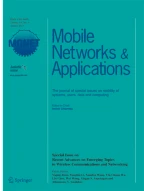Abstract
With the increasing development of communication technology, ultra-dense network (UDN) becomes to be the key technology in the fifth generation (5G) communication. More and more small cells appear in the UDN, which leads to serious interference to harm network performance. To solve this problem, this paper proposes a novel scheme with clustered priority-based user-centered interference coordination (CPUCIC). User performance is improved with base station collaboration and interference nulling in the respective cluster area. Numerical results show that related performances with CPUCIC scheme can be improved with respect to signal to interference plus noise ratio (SINR) and spectrum efficiency (SE). Furthermore, its performance improvement is greater than bandwidth cost in most cases, which metrics is user bandwidth gain-to-loss ratio (UBGLR).
Similar content being viewed by others
References
Kamel M, Hamouda W, Youssef A (2016) Ultra-dense networks: a survey. IEEE Communications Surveys & Tutorials 18(4):2522–2545
Agiwal M, Roy A, Saxena N (2016) Next generation 5G wireless networks: a comprehensive survey. IEEE Communications Surveys & Tutorials 18(3):1617–1655
Ge X, Tu S, Mao G, Wang CX, Han T (2016) 5G ultra-dense cellular networks. IEEE Wirel Commun 23(1):72–79
Tang X, Ren P, Gao F, Du Q (2017) Interference-aware resource competition toward power-efficient ultra-dense networks. IEEE Trans Commun 65(12):5415–5428
Zhang H, Min M, Xiao L et al (2018) Reinforcement learning-based interference control for ultra-dense small cells. In: IEEE global communications conference, pp 1–6
Yang C, Li J, Ni Q, Anpalagan A, Guizani M (2017) Interference-aware energy efficiency maximization in 5G ultra-dense networks. IEEE Trans Commun 65(2):728–739
Xiao J, Yang C, Anpalagan A, Ni Q, Guizani M (2018) Joint interference Management in Ultra-Dense Small-Cell Networks: a multi-domain coordination perspective. IEEE Trans Commun 66(11):5470–5481
Jihoon C, Choonggeun S, Jingon J (2018) Wireless powered information transfer based on zero-forcing for multiuser MIMO systems. IEEE Trans Veh Technol 67(9):8561–8570
Agrahari A, Varshney P, Jagannatham A (2018) Precoding and downlink beamforming in multiuser MIMO-OFDM cognitive radio systems with spatial interference constraints. IEEE Trans Veh Technol 67(3):2289–2300
Ashikhmin A, Li L, Marzetta T (2018) Interference reduction in multi-cell massive MIMO systems with large-scale fading precoding. IEEE Trans Inf Theory 64(9):6340–6361
Shafin R, Liu L (2019) Multi-cell multi-user massive FD-MIMO: downlink precoding and throughput analysis. IEEE Wirel Commun 18(1):487–502
Qu D, Zhou Y, Tian L, Shi J (2016) User-centric QoS-aware interference coordination for ultra dense cellular networks. In: IEEE global communications conference, pp 1–6
Zhang G, Ke F, Peng Y, Zhang C (2018) User access and resource allocation in full-duplex user-centric ultra-dense heterogeneous networks. In: IEEE global communications conference, pp 1–6
Zhang Y, Bi S, Zhang Y (2018) User-centric joint transmission in virtual-cell-based ultra-dense networks. IEEE Trans Veh Technol 67(5):4640–4644
Cao L, Hu X, Zhang M et al (2015) Interactive CoMP with user-centric clustering based on load balancing in 5G dense networks. In: IEEE international conference on communications workshops, pp 1–6
Slovenia L (2009) Leakage-based precoding for CoMP in LTE-A, pp 1–17
Zhao G, Chen S, Zhao L, Hanzo L (2017) Joint energy-spectral-efficiency optimization of CoMP and BS deployment in dense large-scale cellular networks. IEEE Trans Wirel Commun 16(7):4832–4847
Zhang W, Lamare R, Pan C et al (2017) Joint energy-spectral-efficiency optimization of CoMP and BS deployment in dense large-scale cellular networks. IEEE Trans Wirel Commun 16(5):3298–3312
Zhang C, Jing Y, Huang Y, Yang L (2018) Performance analysis for massive MIMO downlink with low complexity approximate zero-forcing precoding. IEEE Trans Commun 66(9):3848–3864
Feng F (2016) Research on scheme of interference suppression for downlink ultra dense networks. Hohai Univisity
Acknowledgements
This work was supported in part by the National Natural Science Foundation of China (No.61701168,61832005,and 61571303), the Fundamental Research Funds for the Central Universities(No.2014B33114).And we thank Lei Chen for his valueable suggestions for our revision work.
Author information
Authors and Affiliations
Corresponding author
Additional information
Publisher’s Note
Springer Nature remains neutral with regard to jurisdictional claims in published maps and institutional affiliations.
Rights and permissions
About this article
Cite this article
Wu, G., Tan, G., Jiang, D. et al. User-Centered Interference Coordination in the Ultra-Dense Network: a Cluster and Priority Perspective. Mobile Netw Appl 26, 1195–1205 (2021). https://doi.org/10.1007/s11036-019-01346-z
Published:
Issue Date:
DOI: https://doi.org/10.1007/s11036-019-01346-z
